Last week, we looked at the history of this beloved franchise as it developed in its home country of Japan. However, I’m willing to bet that very few of our first Sailor Moon encounters were with Usagi. Instead, we all fell in love with Bunny or Serena instead. We’re going to talk about it. Be prepared to cringe with nostalgic glee.
Like I said last week, this article is going to specifically focus on the North American dub, since that’s the one that I (and probably most of our readers) know the best. If you grew up with a dub in another language, though, then absolutely feel free to let us all know your own experiences with the show at the end of the post! Next week we plan to write about the fandom as a whole, so your insights will certainly be valuable.
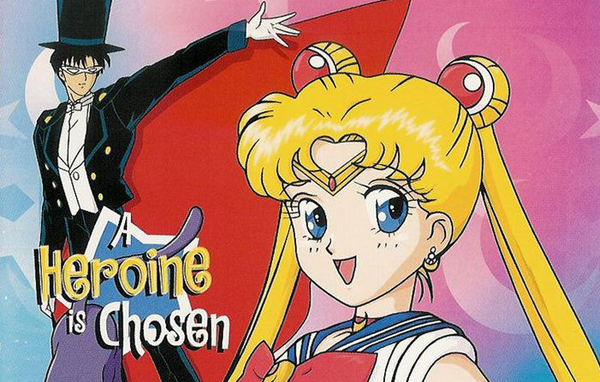
From one of the DiC VHS covers.
After Sailor Moon became an hit in Japan, it gradually started to make its way into international markets. Spain and France were the first countries to air their own dubbed versions of the series in 1993 (and by the way, you should take a quick break to listen to the French version’s theme song, because it’s fantastically dorky and much too catchy. I’ll wait), and nine other countries followed suit over the next few years. It wasn’t until 1995–a year after Mighty Morphin Power Rangers aired to massive success–that North American companies decided to pick up on the series, seeing the potential for a fighting superhero team that capitalized on girl power. Just like Toei Animation did! What a coincidence!
But it wasn’t smooth sailing at first; initially a bidding war between DiC Entertainment and another company called Renaissance Atlantic broke out over the rights. Dubbing anime shows for American audiences hadn’t been exactly popular at that point, but it had been done before and would have been pretty cheap–all you really need to do is add new voices. Renaissance Atlantic, however, wanted to do something different. So they hired an animation company called Toon Makers to produce a hybrid live-action/Western animated version of the franchise and pitch it to Saban Entertainment, the company that originally adapted Kyōryū Sentai Zyuranger into Mighty Morphin’ Power Rangers.
What happened was… this.
Affectionally dubbed “Saban Moon” after Saban Entertainment, the above series never made it to production. The above music video did, however, end up being the laughingstock of a 1998 Anime Expo, and then made its way onto the Internet and lived there in infamy just under the surface of Sailor Moon fandom at large.
While a real pilot was never created and we don’t know much about the concepts behind Saban Moon, we do know from an interview with Toon Maker president Rocky Solotoff that they wanted the series to be “as politically correct and diverse as possible.” (In the actual interview he falls into the “anime characters are white” fallacy, so watch out for that.) Judging from the above video and from cels of the characters, they definitely accomplished that. And c’mon–I know we’re laughing at this video because it’s cheesy compared to the original, but we all would have watched the hell out of this show. The ’90s was a very, very cheesy time.
Speaking of cels: part of the reason why Saban Moon has seen such a resurgence within the fandom is because a large number of animation cels began to surface on eBay in 2012, as well as a script for the 17-minute proof-of-concept video that was also produced. Saban Moon fanart exists, because of course it does. Also, one time somebody cosplayed as Saban Moon. That person is my hero.
Oh, and those crescent moon flyers that all the scouts are riding on? Those did eventually become a Sailor Moon toy that you could buy, more or less.
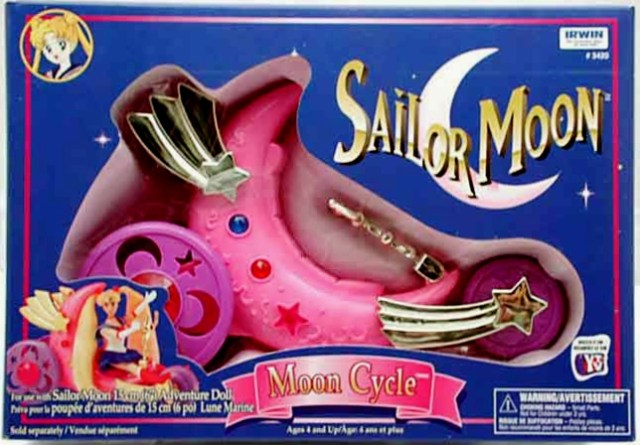
Eventually DiC Entertainment procured the rights from Bandai, who had a business alliance with Toei Animation, to produce the North American Sailor Moon dub. They were worried, however, that kids would get confused by the inherent Japan-ness of the original cartoon, so in addition to changing all the names of the characters to be more “American,” they naturally decided to either edit all of those parts out or write around them. Pork buns became doughnuts; “Serena” was a meatball-head instead of a dumpling-head; scenes that depicted people driving cars were reversed so that the steering wheels were on the opposite sides, and Japanese writing was rotoscoped, or airbrushed, out.
Now that anime is such a popular genre outside of Japan and is celebrated, this seems practically unthinkable to a modern audience. At the time, however, it was not an uncommon practice, particularly the changing of names. Most countries changed Usagi’s name to “Bunny” and altered her last name to be closer to their respective cultural expectations in their initial version of the sub (though some, like Germany, Russia, and Indonesia, did not). Pokémon, Digimon, and Yu-Gi-Oh were also subjected to this same type of treatment later in the ’90s, and it still happens today sometimes–what, you think they actually named the Ace Attorney “Phoenix” in Japan?. Pfft.
More striking, though, were the heavier content changes made to the show. In Japan, Sailor Moon was originally marketed to slightly older girls, but in North America it was aimed at much younger kids, so things that were deemed offensive or upsetting to children (EDIT: Japan also has much different cultural rules for what’s “child-appropriate,” which we should also point out) were cut. The second episode of the series, for example, which deals entirely with kids becoming delinquents and prominently features Umino (Melvin in the dub, because what else would you name a nerd?) lifting up their teacher’s skirt, never made it over here. Other upskirt shots were removed as well, and the transformation sequences of each scout were airbrushed to erase the outlines of their breasts.
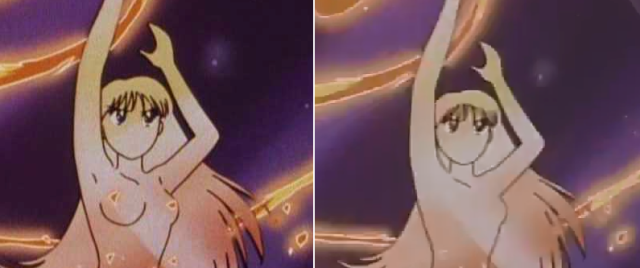
On the left, Rei’s original transformation into Sailor Mars. On the right, Raye from the DiC dub. (image via WikiMoon)
Oh, and then there was Zoisite, of course. In the original, he’s an effeminate and very fabulous man in a relationship with a fellow male villain. In the dub, she’s a woman. Other countries did this as well, but most–including Portugal, Russia, Korea, and France (although in the French version he and his lover Kunzite were “brothers”)–kept him male.
There was also a lot of violence that was cut, too, such as scenes where a brainwashed Tuxedo Kamen (Tuxedo Mask in most dubs, since that’s what “kamen” actually means) attacks Sailor Moon later in the series, or where the scouts get particularly rough with one another. Most egregiously, the final two episodes of the first season, when each of the scouts dies to protect their princess and then are miraculously brought back to life by Sailor Moon’s silver crystal, are awkwardly spliced together and altered so that they’ve simply been “kidnapped by the Negaverse.” The A.V. Club did a pretty solid analysis of this episode in particular that I recommend, if you’re so inclined.
The pacing, music, and tone of the series were also changed, for better or worse. Basically, they were more… ’90s. People called each other “Creepazoid” and “dream hunks,” stuff like that. Here’s a video for comparison, of the scene where Mamoru/Darien reveals his secret identity to Usagi/Serena.
Fun fact! All the voicework for the dub was done by a company in Toronto called Optimum Productions, who continued on with the series after DiC had been dropped. Bless their beautiful Canadian hearts.
Not all the changes made were terrible-horrible-no-good-very-bad, though. Episode 4, which originally has a weight loss plot line that’s very anti-fat, was rewritten to be more body positive and accepting. Villain names that could be construed to have a racial or colorist connotation to them in the U.S.–the Dark Kingdom and Black Lady in particular–were also amended (and I will fight you to the death over the merits of Negaverse. It’s a great name. Try saying it out loud right now, just for fun. NEGAVERSE). And despite the gender-swap, the actress playing “Zoycite” was actually one of the highlights of that first season. She was, in fact, fabulous.
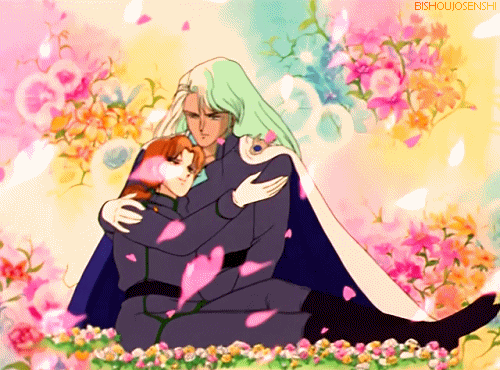
So, so fabulous.
There was also an adorably goofy “Sailor Says” short at the end of every episode that tried to turn the story into something educational for kids, kind of like the PSAs at the end of Captain Planet. Were they kind of patronizing? Probably, yes. But looking back on them fills my heart with this wonderful nostalgic warmth. How can you say mean things about a PSA that tells kids to believe in themselves and be nice to their friends?
DiC produced the first season and a half of Sailor Moon from 1995 to 96, picking up the latter 17 episodes sometimes in 97 (and oh, boy, what a mess that was–we’ll talk about it next week). At the time the show was syndicated into a 6:30am time slot that, while negatively impacting its overall numbers, somehow did not manage to render it unseen by thousands of little American and Canadian girls in the 90s. I don’t ever remember making a conscious decision to watch TV before my parents had woken up when I was but a wee elementary school student, but those Sailor Moon bedsheets I slept in didn’t just spontaneously appear on my bed by magic, so it must have happened at some point.
Speaking of which, do you guys remember that one time there was a marathon of the show that featured live-action lead-ins? I’m very glad I don’t.
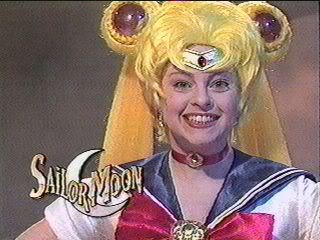
THE ’90S, Y’ALL.
In 1998, Cartoon Network secured the rights to re-air the first two seasons and then comissioned Cloverway (an international branch of Toei Animation) to pick up where DiC left off with S and SuperS in 2000. Because there was now a TV rating system in place, they could get away with more violence and mature themes in their “adaptation” than the previous dub; the Sailor Says segment was dropped, and the show was instead geared a little more towards the preteens who’d watched the first few seasons five years ago. Cloverway was also less shy about acknowledging the show’s Japanese origins and left much of the music, opening animation sequences, and even some of the character intact.
Despite all of this, things with Cloverway were not moon-puppies and sailor-sunshine. They kept to the time honored tradition of gender-swapping villains to be more acceptable to societal norms (in SuperS, the crossdressing Fish Eye became female and the ugly, elderly Zirconia became male) and also edited the relationship between Sailor Uranus and Neptune–who, to borrow a phrase form 30 Rock, are “totally gaybones for each other”–to make them cousins instead.
You are not fooling anyone with all that “Brad” talk, Michelle.
Not that international versions of Haruka and Michiru were that kind to their originals, either: most dubs portrayed the relationship as strictly platonic. The French version went a step further, positing that Haruka was pretending to be a man to hide her identity and Michiru only pretended to be her girlfriend. The French version sounds like a weird time, you guys.
The final season of the anime, Stars, never made it to North America. Fans speculated that this is because of characters who frequently switched genders, rampant character deaths, and a whole bunch of nudity at the series’ end. However, it’s actually because Toei–and therefore, Cloverway–got in a feud with series creator Naoko Takeuchi and lost the rights to the franchise. Although the Starlights did make it onto television in other countries (although they were usually changed or censored in some way so that they weren’t changing from male to female; in Italy, they were actually split into three different sets of twin siblings who just switched places with each other), English-speaking fans who wanted to know how the series ended had to either find fansubs or deal with disappointment.
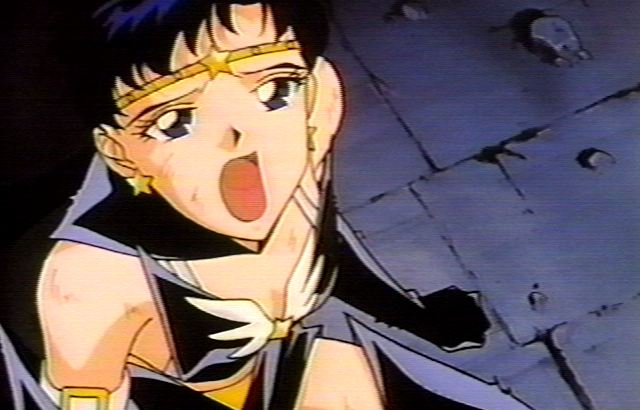
“But I wanted a dub name! I could have been ‘Stevie!’ IT’S GENDER NEUTRAL!”
And that was it, for a while. Toei did not want to sell the rights to any more companies, so the show remained in cold stasis for years, like so many future Crystal Tokyo residents. Right up until Neo Queen Serenity–I mean, right up until Viz Media showed up, of course. More on in a second.
But what about the manga, you’re probably asking? There’s less to say about its journey to North America, in part because there were much fewer structural changes made to it than to the cartoon, and so less backwards hilarity to track. The story was translated to English by Mixx (later Tokyopop) and brought over to U.S. and Canada in 1998, after the first dub had already ended, for syndication in Mixxine and then in Smile magazine. Mixx, of course, had its own share of controversies on the business end, but few of those appeared to directly impact Sailor Moon, its first big translation project.
While the American version of the manga was also intended for a younger audience than Mixx’s usual fare (thought not as young as the original dub), there were very few significant structural changes to the overall story. The inner scouts kept their first names from the dub and their last names from the original–save for Usagi, who was “Bunny.” The outer scouts completely kept their original names, because the Cloverway dub hadn’t come out yet.
Of course, many more nuanced aspects of Japanese culture were lost in translation, and the books were flipped so that they read left to right. But, on the whole, the manga-reading experience was muuuuch more satisfying to someone who might have been frustrated with the way the Cloverway dub had been going. You know, no cousins or anything like that. The opposite, in fact! Everybody was totally gaybones!
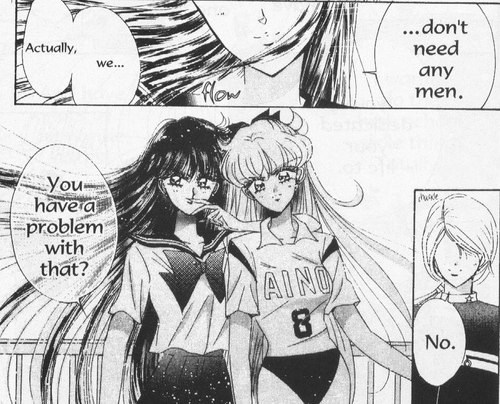
From the Mixx Stars run. Three guesses why this is my favorite translation of this scene.
However, other parts of the Mixx translation are… not great. Like, “typos everywhere, why are you wording this so weirdly” kind of not great. In particular I have very vivid memories of a wonderfully bungled scene in the Dead Moon arc when Hotaru is supposed to be reciting The Second Coming by William Butler Yeats, but nobody on the Mixx team realized that the poem was originally written in English and instead directly translated the Japanese translation. The desert birds were, to put it mildly, indignant.
It wasn’t until after Sailor Moon was finished that Tokyopop really hit their stride with translating and began keeping the books in their original right to left format. By then, they’d already lost the rights to the series and could not republish it; all the Mixx editions are now rare and out-of-print. If your copies are anything like mine, they are also probably falling apart.
If this were four or five years ago, the story would end there–no more anime, no more manga, go find yourself some fansubs. But take heart, fellow Moon dorks! Because of that huge resurgence in popularity we were talking about last week, there are now ways for many international Moonie fans to get their fix. In 2010, Toei negotiated the rights to broadcast Sailor Moon on Mediaset in Italy, which marked the first time that the series had been picked up outside of Japan since the international rights fell through in 2004.
Then in 2011, Kodansha USA announced their intention to bring the 10th anniversary editions of the manga to an English-speaking audience, as well as the first-ever translation of Codename Wa Sailor V. The Kodansha version, while not always perfect and sometimes grammatically clunky, is generally accepted to be better than the Mixx one.
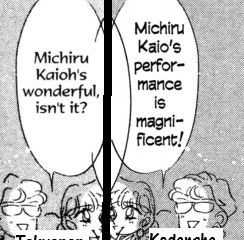
From A Second Chance for the Sailor Moon Manga. Michiru is a person, guys. A very elegant one who would not appreciate such talk.
Most recently, Viz Media announced that not only had they secured the rights to the uncut, original Japanese version of Sailor Moon, but they’ll also be redubbing the original series and the Sailor Moon Crystal reboot that’s set to drop on the fifth. It’s unclear when the two dubbed versions will drop on Hulu (I’m gonna take a wild guess and say that they’ll definitely be on the upcoming DVDs and Blu-Ray editions), but the classic Japanese series has been coming out two episodes at a time every Monday, and the new series will air twice a month on Crunchyroll, Hulu, and NicoNicoDouga. Excitement? Excitement!
Depending on who you ask, the dub and original translated versions of Sailor Moon are clunky, racist, and homophobic mockeries of the franchise’s original forms, or they’re a more easily accessible alternative with fewer cultural and visual (for people who can’t read subtitles) barriers to overcome. Years worth of intense comment wars have been fought in the Sailor Moon fandom over which is better, with the sub usually eeking out first on account of “authenticity.” But most of us still owe a lot to Serena and Bunny, even knowing what an insufferable ditz she can be. In fact, a lot of us around the world would never have gotten the chance to fall in love with Sailor Moon as we know her now without these initial translations, as terrible as they can be sometimes.
So here’s to you, Sailor Moon dub. Thanks for your Negaverse, your awkward dialogue, your cheesy-yet-valuable morality lessons, and for righting wrongs and triumphing over evil (and that means us, I guess). You may be gone, but you’ll never be forgotten–mostly because we can’t get your dorky version of the theme song out of our heads.
Next Week: FANDOM FANDOM FANDOM. We discuss the Save our Sailors campaign, the Moon Animate Make-up campaign, the overabundance of Sailor Earths, and how Sailor Moon impacted us all as a community. It’s gonna get dorky.
- A Ridiculously Comprehensive History of Sailor Moon – Part 1: Made In Japan
- In the Name of the Moon, the First Sailor Moon Crystal Trailer Is Here
- Official Sailor Moon Premiere Party Excludes Unaccompanied Men
Are you following The Mary Sue on Twitter, Facebook, Tumblr, Instagram, & Google +?



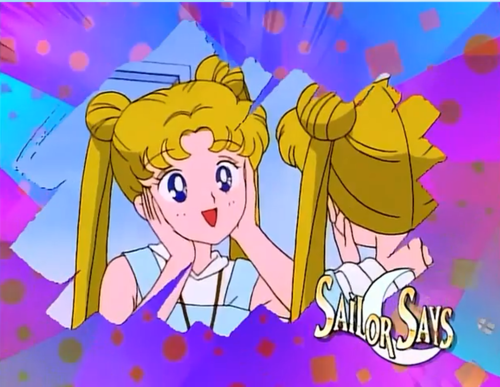





Published: Jun 25, 2014 01:15 pm